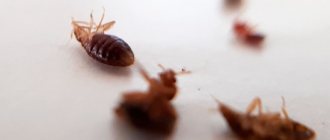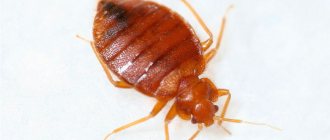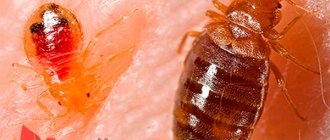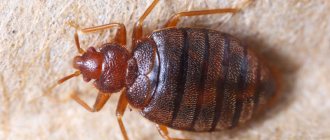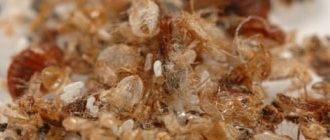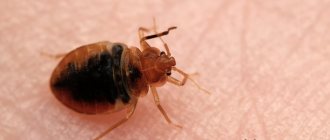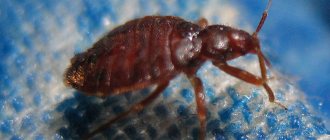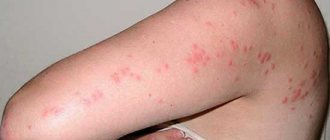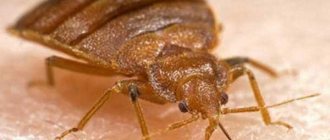Types of bedbugs
The planet is inhabited by about forty thousand different species of bedbugs. They differ so greatly from each other in lifestyle, eating style, and appearance that often only a specialist is able to recognize a bug in an insect. Of the few unifying features, one can name the structure of the oral apparatus common to all species. Regardless of the species, it piercingly sucks on all bedbugs. Some species feed on blood, others on plant juices. Nutrient fluids are different, but the principle of their absorption is the same. Another striking sign of a bug is a specific and rather strong odor, which is secreted by special glands located on the insect’s abdomen between the first and second pairs of legs. On the one hand, they perform a communicative role between individuals of the same species at the chemical level - the composition of the secreted liquid is close to pheromones. On the other hand, they scare away enemies. That, perhaps, is all that makes representatives of different species similar, and then the peculiarities begin. Among the bugs that live in gardens and vegetable gardens, there are both pests and protectors that can save the crop from other insects. Such defenders include the bug soldier
.
It faithfully serves gardeners by eating the eggs of insect pests. Some bedbugs are specially bred in gardens and vegetable gardens. Such “privileged” species include Podisus
bug .
He is the only one who hunts the Colorado potato beetle, which earned him fame as the best savior of potatoes. The antipodes of beneficial bugs include cruciferous bugs
, which destroy cabbage seedlings with full confidence that they were planted specifically for them.
This right is not disputed even by birds who do not risk tasting an insect that emits a strong and unpleasant odor. Another common pest of gardens and vegetable gardens is the turtle bug
.
Young trees and seedlings suffer from it. It attaches itself to green shoots and sucks out all the juices from them. Waterfowl bugs include the water strider
and
smoothie
, which is also called the water wasp.
Both species are predators, hunting mosquitoes, their larvae, midges and other small insects that live above the surface of water bodies. Both species roam the watery expanses of ponds and lakes, occasionally venturing onto land. Both species have well-developed wings, allowing them to move long distances in search of better places to live. They are similar in almost everything except appearance. An elegant water strider, easily gliding across the surface of the water as if on ice, looks like a graceful ballerina in comparison with the “wide-shouldered, heroic build” smoothie. They cannot be called a harmonious couple. Apparently this is why they prefer to settle in different ponds. A large group consists of parasitic bugs that feed on the blood of larger organisms. About 30 species parasitize animals, birds, and bats. And only some species prefer human blood. A prominent representative of them is the house or bed bug.
Bed bugs
Bed bugs are synanthropic insects. They parasitize humans and cannot exist outside human habitation. Eras, human living conditions, the exterior and interior of houses, engineering communications change, and only the presence of bedbugs remains unchanged. The instinct of self-preservation leads them to humans, and this is the most accurate compass in the world! The bug knows that next to a person it is always warm and satisfying. And it is not so important what is the source of heat in the home - a fire in a cave or central heating radiators in a fashionable house. Where a person is comfortable, a bug will be comfortable there. And everything else is not significant and does not in any way affect the magnetic attraction of parasites to their victims.
Interesting breeding
The reproduction of bedbugs is a source of fascination for biologists. Young males have a passionate temperament, if you translate it into human language. They have sexual relations with females, nymphs of different ages, males, and even other insects. During sexual intercourse, the partner’s abdomen is pierced anywhere and seminal fluid is injected.
Reproduction of bed bugs
If sexual intercourse occurs with another male, the amount of seminal fluid inside increases. Such a creature is called a mega male. Having discovered a sexually mature female, he transfers all this to her. If compared to a human, the amount of sperm will be 5 liters.
This reserve is enough for the female to last her entire life. The female begins to lay eggs. Gradually takes up reserves of seminal fluid and no longer needs re-fertilization.
Interesting!
To infect a premises, it is enough for one sexually mature female to enter the house. The domestic parasite lives for about a year and lays up to 300 eggs throughout its life.
What do house bugs look like?
The size of the bug can vary from 3 to 7 millimeters. It is easily recognized by its highly flattened, segmented, oval-shaped body. The small head is equipped with everything necessary to find a source of food and feed the body in a timely manner - eyes, antennae and a massive mouthparts with a pronounced sharp proboscis, with which the bug pierces human skin like a needle. As the body segments become saturated, they become filled with blood, stretched, and rounded. It is difficult to distinguish any parts of the body of a completely satisfied bug that has fallen off the victim - it looks more like a round bead than an insect.
You can learn more about what bedbugs look like in our separate article.
Taste preferences
House bug bites
The insect is a parasite of humans. Bed bugs feed only on blood. The victim is found by the smell of carbon dioxide, which is released when a sleeping person exhales. Blood not only replenishes vital energy, but is also a trigger for the next stage of development in nymphs, the laying of eggs in adult adults. Before each process, a new portion of food is needed.
On a note!
In an emergency situation, when there is a question of life and death, a bedbug may covet the blood of an animal, but such nutrition will be incomplete. The domestic parasite will not have the opportunity to develop further or lay eggs.
Where do bedbugs live in an apartment and how to detect them
Bedbugs settle in secluded, dark and hard-to-reach places near the bed where a person sleeps. The power source must be in close proximity to the socket. Therefore, you can find clusters of bedbugs and their eggs behind the baseboard of the wall next to which the bed stands, under the bed itself, under the bedside rug, in the depths of the bed or sofa, and even bedside tables. The bug cares about its comfort and is not ready to make long hikes every night just to have dinner. However, if the victim disappears from its usual place and moves its bed to another room, then the bug will also not be too lazy to move with its entire family and will settle into a new place of residence. He is able to travel vast distances in search of food, following the smell of blood, which he smells, even if there are no open wounds or scratches on the human skin.
If you want to find bedbug nests in your apartment yourself, use our method described in a separate article.
Typical places where bedbugs live:
- Elements of upholstered furniture;
- Skirting boards near sleeping places;
- Behind furniture pushed tightly against the wall;
- Behind the carpets hanging on the walls;
- For paintings, posters;
- In the folds of curtains;
- Behind the sockets;
- In the seams of mattresses;
In densely populated apartments, bedbugs multiply quickly and soon they become as crowded as people, and therefore they can be seen even in places unusual for them during the daytime! This fact eloquently suggests that the number of individuals has reached the permissible limit even for bedbugs - they simply no longer fit in their nests, and the unoccupied secluded places for comfortable living have all run out! This is a dangerous situation, which indicates a severely neglected sanitary condition of the apartment, threatening the health of the people living in it!
Special Egg
Interesting facts about bedbugs are not complete without a description of the egg. The female lays eggs in a nest that is located away from sunlight, closer to a food source, with a comfortable temperature.
Interesting!
The egg is no more than 1 mm, difficult to notice with the naked eye. But the shell is so strong that it protects the embryo from temperature fluctuations and the action of insecticides.
The egg of a domestic bug can withstand temperatures of about -15 degrees Celsius, within +55 degrees Celsius. To destroy the parasite in an apartment, it is necessary to apply low and high temperatures for about 3 minutes.
Even the most modern insecticide is not able to kill the larva in the egg, not to mention folk remedies. Destruction occurs only after its birth. It is recommended to re-disinfestate 14 days after the first.
How long do bedbugs live and what are they afraid of?
The average lifespan of a bedbug is approximately 12 months. Although this figure is very arbitrary. Any changes in the temperature in the room affect its lifespan. An increase in temperature accelerates development and thus shortens the life cycle. A decrease in temperature, on the contrary, slows down the maturation and development of the new generation, increasing the overall life expectancy.
We should not forget that under unfavorable living conditions, the bug hibernates and can remain in a state of suspended animation for quite a long time. The bug does not die, but all life processes slow down so much that there can be no talk of any activity. This ability to fall into lethargic sleep has helped the bug survive many natural disasters on the planet, unlike humans. When entire civilizations perished, the bug preserved its life until better times and was revived for active activity and reproduction at the first opportunity.
ATTENTION
A bug can remain in a state of suspended animation for a year. If his hibernation is associated with a strong drop in temperature, then his lethargic sleep can last indefinitely - until it gets warmer. The bug can easily tolerate low temperatures ranging from minus 5 to minus 10.
The bug turns into ice, but it is this condition that keeps him alive. As the temperature rises, the resilient parasite thaws and attacks food with redoubled appetite. Temperatures below minus 22 degrees or above plus 40 can kill him.
In addition to extremely low and extremely high temperatures, bedbugs are afraid of sharp and strong odors. Of course, the odors of bedbugs will not physically destroy them, but they can scare them away and force them to migrate. Such odors include: table vinegar, acetone, perfumes with a strong aroma, ammonia, denatured alcohol, kerosene, turpentine.
The smells of certain plants can also repel bedbugs for a while. The most effective of them are wormwood and tansy. You can learn more about what smells bedbugs are afraid of in a separate article.
However, for serious control of a large population of bedbugs, it is better to use professional insecticides and appropriate equipment.
Why are bedbugs dangerous?
An allergic reaction of the body to bedbug bites is the most harmless consequence of contact with parasites. Everything can be much more serious and sad under certain circumstances. Much depends both on the state of health of the person and his immune system, and on the degree of infection of the bug with various viruses.
FACT
It has been scientifically proven that the bedbug is a carrier of viral diseases such as tuberculosis, typhoid fever, anthrax, and hepatitis. All these viruses enter the insect’s body along with the blood of a sick person on whose body it has parasitized.
The bug feeds on blood, so there is a chance of contracting any of the diseases that are transmitted through blood. And although some virologists do not see a direct threat of infection through the bite of an infected bug, this possibility cannot be completely dismissed. Not only bedbug bites are dangerous for humans, but even its excrement, in which the hepatitis B virus persists for a long time. Feces can be in a person’s bed, because the insect defecates in the same place where it eats, without bothering itself with creating a special latrine. A sleeping person may involuntarily inhale small particles of excrement or accidentally introduce them into the mouth. Once in the human body, the virus will begin to develop, causing disease and destruction.
What do bedbug bites look like?
Not all bedbugs bite their victims the same way. The classic option is a path of several consecutive punctures. That is, the bug is not satisfied with the blood sucked from one wound, and therefore makes several of them in one meal. However, this academic version of bites is not always found. Bedbugs, like any living creature on the planet including humans, have their own distinctive characteristics, taste preferences and feeding habits. Therefore, more often than not, a bug bite differs little from the bite of any other blood-sucking insect. An inflamed swelling of pink or red color with a pronounced skin puncture site inside. This is what a bite from any blood-sucking insect, including a bug, looks like. You can learn more about how to distinguish a bedbug bite from other insects in our separate article.
Routes of penetration
It is a mistaken belief that bed bugs enter an apartment or house with pets from the street. Pests live only indoors, parasitize the human body, and are not interested in animal blood.
House bugs are brought into the house by the person himself with furniture, things, clothes, interior items, and household appliances. Or they enter through cracks, doorways, or sockets from a neighbor.
On a note!
In an apartment, bed parasites choose the room closest to the sleeping person. Only with severe infestation do they form several nests throughout the house or apartment. They are nocturnal. During the day they hide in secluded places and come out to feed late at night and early in the morning when the prey is sleeping.
You can pick up a bedbug by spending the night in an infested room, or by leaving your belongings there. Most often they form nests in the sofa or bed.
There are many interesting facts about bedbugs that surprise, intrigue, and amaze.
Remedies for bedbugs
Let's consider what means it is possible to defeat bedbugs.
Bedbug sprays
Spray is one of the most effective means for killing bedbugs. As a rule, drugs are produced in the form of solutions that are diluted with water in accordance with the instructions. The task is to prepare a solution and pour it into a spray bottle. Small spray bottles are sold in the Garden and Vegetable Garden departments of any large supermarket or hardware store. However, any empty drinking water bottle with a sprayer screwed to the neck is suitable for this purpose.
The best results will be obtained by a spray based on professional highly concentrated insecticides, with an active ingredient content of 20% or more, usually based on Malathion. Ready-made sprays in cans, which can be bought at a hardware store, are usually not very effective and have a small volume; remember that to treat an apartment you need several liters of a working solution, which is sprayed over all the main surfaces where bedbugs can be located or move, and in ready-made ones There is very little of it in cans.
Mashenka and other bug chalks
Chalk Mashenka is a universal means of combating many crawling insects, including bedbugs. Chalk contains four components - two of them are neutral - chalk and gypsum. The other two are the insecticides deltamethrin and zeta-cypermethrin. When toxic substances enter the insect's body, they block the nervous system, resulting in paralysis and inevitable death. Like any means of combating insects, chalk has its pros and cons. The advantages include ease of use at home, affordable cost and relative safety for humans - when using this insecticide there is no need to leave your home and ventilate it for several hours. In addition, the applied line retains its destructive properties for several months. The obvious disadvantages include strictly local action. Therefore, you need to know the nesting places of bedbugs in order to outline them with chalk. You can also outline the approaches to the bed as a protective circle against the evil spirits of the night, but bedbugs can also nest in the depths of the bed itself. In addition, bedbugs will not disappear instantly from such treatment. Quite a long time must pass before representatives of the entire population crawl through the chalk lines and infect their relatives, bringing chalk particles into the nest on their paws. Chalk does not affect bedbug eggs either. You'll have to wait for the birth of a new generation in the hope that they, too, will crawl exactly where you painted the apartment. Meanwhile, bedbugs feed on blood every night and it is not worth extending the process of their destruction for several weeks if there are more effective means with instant results.
Smoke bomb for bedbugs
A smoke bomb is one of the most effective means of fighting bedbugs. Great results without any effort on your part! No need to look for bedbug nests, no need to mix, spray or paint anything. All that is required is to place a checker on a metal tray so as not to damage the floor and set it on fire. And then the smoke will do everything for you - it will spread throughout the apartment, get into all the cracks, saturate the upholstery of upholstered furniture, find nests of bedbugs and instantly destroy them. The main thing is to choose the right checker - not all of them are suitable for disinfecting bedbugs. For example, sulfur-based checkers are good at destroying mold and fungi in damp rooms - they are advisable to use in basements and cellars. Hexachlorane-based checkers are very toxic and are prohibited for use in residential areas. For the destruction of bedbugs, checkers based on peritroids, modern highly effective insecticides, are perfect. This type of checkers includes City, Quiet Evening and Samuro checkers. The active substance in all three is permethrin in varying concentrations. The highest concentration is 13% in the City checker. But you should not perceive this type of treatment as a panacea; it is still better to turn to professionals.
Disinfestation of bedbugs
Professional pest control is the fastest, extremely effective, and most importantly guaranteed option for getting rid of bedbugs. For insect exterminators, this process is a daily job. Experience, skills, and specific knowledge about the habits of insects allow you to find and destroy them without unnecessary delay. The specialist does not need to prepare for disinsection - he is always ready! The most modern technologies, new, fresh and trouble-free insecticides are always at hand. And finally, professionals always guarantee their work for at least a year and work on the object until the insects are completely destroyed.
How to get rid of bedbugs at home
To combat bedbugs at home, any of the above-described bedbug remedies are suitable. At home, you can use bedbug spray, bedbug chalk, or a bedbug smoke bomb yourself. You can also purchase professional insecticides from bedbug extermination companies for a one-time treatment of an apartment and treat the premises yourself.
IMPORTANT
When working with pesticides yourself, remember to wear personal protective equipment! The minimum kit you must acquire is a respirator, rubber gloves, and safety glasses. Do not neglect the safety rules, take care of your health!
When working independently, it is also important to follow the instructions for using bedbug repellents. The instructions for action, the sequence of work, dosages and proportions are always indicated on the packaging of the bedbug remedy. If you have doubts that you can cope with the task, it is better to turn to professionals.
Our website contains a knowledge base about bedbugs, so if you want to know more about this problem, read the articles about what kind of life bedbugs lead, how they reproduce, how to determine whether there are bedbugs, what bedbugs smell, etc.



